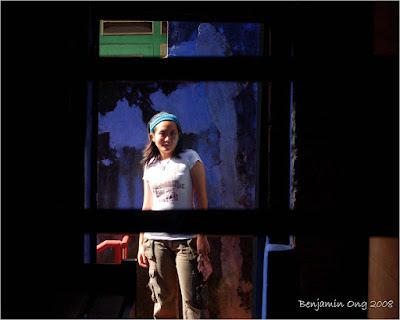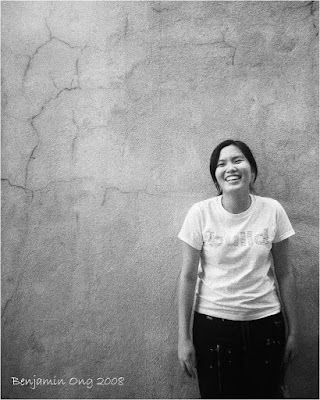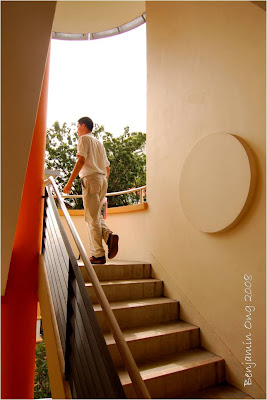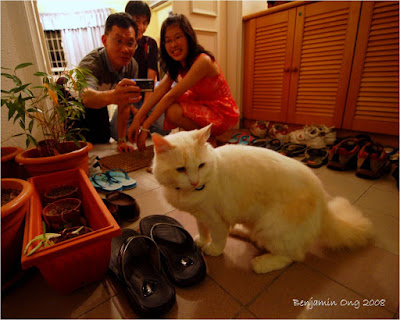I recently acquired a
Nikon FM-10 film SLR, which I consider to be on 'permanent loan' from the Teachers' Christian Fellowship (TCF) Malaysia. They gave it, along with a Canon film SLR, to Tim. He doesn't shoot film, so he figured I'd be able to make better use of it.
It's the most basic of film cameras, although it does have a meter. Film advance and focusing is manual, as is the setting of shutter speed (via dial on camera) and aperture (via ring on lens). If you've seen a traditional film camera, you will know what I'm talking about; if you haven't, go look it up... you don't know what you're missing!
I picked up a roll of year-old expired Kodak Max 400 colour print film from the KPS mini market and shot my college's CC Nite with it. Unfortunately I didn't know how to load the film properly and, as a result, it did not actually advance. Disastrously, I received a blank roll of developed film.
Somehow I managed to load the second roll properly; it was when I loaded it that I realised my mistake with the first roll. Rummaging through the camera bag, I discovered a cable release, a close-up filter and a new roll of Kodak EliteChrome 100 slide film (though I didn't realise this until I loaded it; I really need to read more carefully!). There is also a flash unit, though I don't think I'll be using it anytime soon.
The EliteChrome expired in 2003, but just for fun I decided to try it out. And so with it I shot the Invertebrate Biology field trip at Tanjung Tuan on 29 March, while How manned my D50. The colour was a mess, but amazingly the pictures looked great when I converted them to black-and-white on the computer!
These pictures were shot with the FM-10 and my 50mm f1.8 lens. I didn't have batteries for the meter then, so I estimated exposure using the guide provided in the film's packaging.
* * * * *

Beach scene, Tanjung Tuan.

Three generations of ecologists: Dean of Science and lecturer at the Institute of Biological Sciences Professor Dr Mohd Sofian Azirun, the legendary but degree-less Senior Lab Assistant (retired) Haji Mokhtar Ibrahim, and the future, Thary.

Exploring the ecotone between mangrove and beach. Aerial roots of
Avicennia everywhere.

We found that many animals find refuge in coral, including snails, mussels and this crab.

Sea cucumber,
Holothuria, with Shannon and Amir. Thary later found a really large one!

The rocks exposed at low tide were really quite treacherous, what with sharp quartzite minerals all over the rock surfaces.
How destroyed his slippers (Asadi, I think) along the way.

How and I fell in love with this one.

This shot took some time to grow on me. I asked How to take a picture of my taking a picture of the coral; at first I thought it was 'OK' but How was so sure he'd shot it exactly as I wanted it.
Now as I look at it again and again, I realise he was right.
* * * * *
Lately I've been experimenting with black-and-white prints on consumer photo paper and professional-quality watercolour paper, using the Canon Pixma iP2580 printer I received from UM's Alumni Association.
I tried my hand at watercolouring my black-and-white prints,
a la Eric Peris. The results were quite stimulating!
In the process of all of this, it occurred to me that the print is probably the true end of all photography. Ansel Adams (and undoubtedly legions of photographers in his day) understood this. We do not shoot to amass digital files or negatives, but to produce prints which may end up on cards, bookmarks, in books and magazines, within frames, or on the walls of art galleries.
Talking to Ai Wei recently, I am convinced more than ever that film is more enduring than digital. If you tear a negative in half, you can still print the two halves of the picture; if you break (or even scratch) a DVD containing a thousand photographs, how many of those photographs would still be usable?
* * * * *
Thanks to Kelvin Chan for teaching me how to rewind fully-advanced film, and to Mr Jason Chew for teaching me how to set the ISO dial.
Lots of good stuff here:
http://www.mir.com.my/rb/photography/hardwares/classics/nikonfmseries/fm10/fm10manual/index.htm















































